= Ariocarpus elongatus (Salm-Dyck) Wettst.
Kakteenkunde 1933(1): 13 (1933)
Accepted Scientific Name: Ariocarpus retusus Scheidw.
Bull. Acad. Roy. Sci. Bruxelles 5: 492 (t. 1). 1838
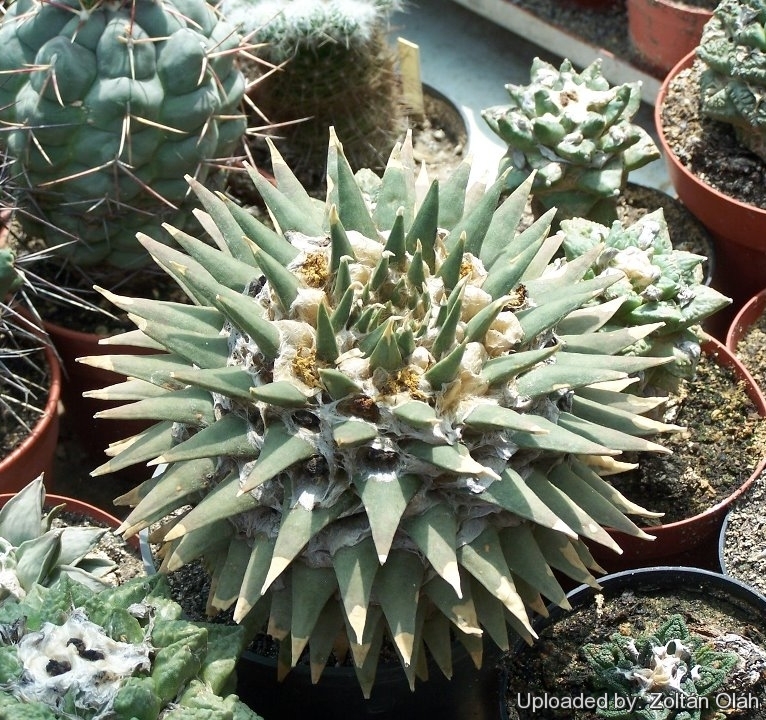
Mammillaria elongata (Ariocarpus elongatus) Photo by: Zoltán Oláh
In a group of plants known for many interesting oddities, Ariocarpus elongatus is one of the great curiosities of the succulent world. It produces longer and thinner tubercles up to as much as 4 cm long. Depending upon growing conditions, the plants may be consistently pale green to blue-green or may be greyish-green. Over time (several decades), the stems eventually grows up to 25 or more cm in diameter.
Origin and Habitat: Entronque El Huizache, San Luis Potosí, México.
Altitude range: Around 1400-1500 metres above sea level.
Synonyms:
See all synonyms of Ariocarpus retusus
back
Accepted name in llifle Database:Ariocarpus retusus Scheidw.Bull. Acad. Roy. Sci. Bruxelles 5: 492 (t. 1). 1838Synonymy: 31
Accepted name in llifle Database:Ariocarpus retusus subs. trigonus (F.A.C.Weber) E.F.Anderson & W.A.Fitz Maur.Haseltonia 5: 18. 1998 [1997 publ. 1998]Synonymy: 7
Cultivars
(11):
back
Common Names include:
ENGLISH: Seven Stars, Golden Stars, Ladyfinger Cactus
LITHUANIAN (Lietuvių): Pailgoji mamiliarija
RUSSIAN (Русский): Маммиллярия удлинённая
SWEDISH (Svenska): Fingervårtkaktus
UKRAINIAN (Українська): Мамілярія елонґата, Мамілярія подовжена
Description: Ariocarpus elongatusSN|2096]]SN|2096]] differs from the standard Ariocarpus retususSN|2079]]SN|2079]] only for its longer and thinner tubercles, all the other characteristics clearly show that they are conspecific.
Taxonomy notes: Ariocarpus retususSN|2096]]SN|2079]] is quite variable and has received numerous unnecessary names of no botanical value, representing no more than local phenotypes: Ariocarpus elongatusSN|2079]]SN|2096]] is one of them. Ariocarpus retususSN|2079]]SN|2079]] is one of the largest species that distinguishes for the fat triangular tubercles forming a starry rosette. It is a widespread and extremely variable plant. Tubercle size and shape vary widely, a terminal areole is sometimes present at the tip. The vast amount of phenotypic variation in the species has led to the erection of several variants and has received numerous unnecessary names of controversial botanical value: Ariocarpus elongatusSN|2096]]SN|2096]] is one of them, but it still has a value for a collector because they identify plants with particular characters.
Habit: Solitary, slow growing geophyte cactus with tubercles slightly projecting above ground level. The flat tuberous body is below the soil.
Stem: Grey, or blue-green, flattened, globose, rounded on top, 3-12 cm high, 10-25 (or more) cm in diameter.
Tubercles: Leaf-like, divergent, becoming attenuate at the apices, not fissured, to 4 cm long, usually 2-2.5 times long than wide.
Areoles: At the tips of the tubercles, rounded, 1-5 mm in diameter only on younger specimens.
Subspecies, varieties, forms and cultivars of plants belonging to the Ariocarpus retusus group
 Ariocarpus confusus Halda & Horáček: intermediates between Ariocarpus retusus and Ariocarpus trigonus flower color, white through to magenta, a color not found in any other populations. Distribution: Aramberri region.
Ariocarpus confusus Halda & Horáček: intermediates between Ariocarpus retusus and Ariocarpus trigonus flower color, white through to magenta, a color not found in any other populations. Distribution: Aramberri region. Ariocarpus elongatus (Salm-Dyck) Wettst.: has longer an narrower tubercles than Ariocarpus retusus. Distribution: Huizache, San Luis Potosí.
Ariocarpus elongatus (Salm-Dyck) Wettst.: has longer an narrower tubercles than Ariocarpus retusus. Distribution: Huizache, San Luis Potosí. Ariocarpus furfuraceus C.H.Thomps.: has equilaterally triangular shaped tubercles.
Ariocarpus furfuraceus C.H.Thomps.: has equilaterally triangular shaped tubercles. Ariocarpus furfuraceus f. cristata Frič: crested form.
Ariocarpus furfuraceus f. cristata Frič: crested form. Ariocarpus furfuraceus f. monstruosus hort.: Free branching plants with thinner elongated stems and copious production of wool. There are several different clones.
Ariocarpus furfuraceus f. monstruosus hort.: Free branching plants with thinner elongated stems and copious production of wool. There are several different clones.- Ariocarpus furfuraceus var. rostratus A.Berger: (Ariocarpus retusus var. furfuraceus ''rostratus'') Refers to plants with a more tapered apex to the tubercle.
 Ariocarpus retusus Scheidw.: (ssp. retusus) Widespread, flowers are cream or white, occasionally with reddish midveins.
Ariocarpus retusus Scheidw.: (ssp. retusus) Widespread, flowers are cream or white, occasionally with reddish midveins. Ariocarpus retusus f. cristata hort.: is a slow-growing crested cactus forming with fan shaped stems that will slowly forms brain-shaped cushion up to 3-12 cm high and 70 cm in diameter, or more.
Ariocarpus retusus f. cristata hort.: is a slow-growing crested cactus forming with fan shaped stems that will slowly forms brain-shaped cushion up to 3-12 cm high and 70 cm in diameter, or more. Ariocarpus retusus subs. horacekii Halda & Panar.: like Ariocarpus trigonus but smaller. Distribution: South of Matehuala, San Luis Potosí.
Ariocarpus retusus subs. horacekii Halda & Panar.: like Ariocarpus trigonus but smaller. Distribution: South of Matehuala, San Luis Potosí.- Ariocarpus retusus subs. jarmilae Halda, Horáček & Panar.: nomina nuda
- Ariocarpus retusus subs. panarottoi Halda & Horáček: Nomina nuda.
 Ariocarpus retusus subs. pectinatus Weisbarth: It has, dull pectinated spines already present in young specimens up to 1,2 to 2,0 mm long. The spines persist with the age. Areoles at the tips and extending on the upper side of the tubercles, elongated 2 to 20 mm long, wooly.
Ariocarpus retusus subs. pectinatus Weisbarth: It has, dull pectinated spines already present in young specimens up to 1,2 to 2,0 mm long. The spines persist with the age. Areoles at the tips and extending on the upper side of the tubercles, elongated 2 to 20 mm long, wooly.- Ariocarpus retusus subs. scapharostroides Halda & Horáček: Plants from the Villa Juarez region of SLP, it is characterized by erect angular tubercles, superficially reminiscent of Ariocarpus scapharostrus.
- Ariocarpus retusus var. sladkovskyi Halda & Kupčák
 Ariocarpus retusus subs. trigonus (F.A.C.Weber) E.F.Anderson & W.A.Fitz Maur.: (Ariocarpus retusus ssp. trigonus) Somewhat less widespread with long sharp tubercles twice as long as wide. The flowers are yellow (usually), white to pinkish white.
Ariocarpus retusus subs. trigonus (F.A.C.Weber) E.F.Anderson & W.A.Fitz Maur.: (Ariocarpus retusus ssp. trigonus) Somewhat less widespread with long sharp tubercles twice as long as wide. The flowers are yellow (usually), white to pinkish white. Ariocarpus retusus cv. Cauliflower: has a completely or partially warty skin that gives it an aspect of cauliflower.
Ariocarpus retusus cv. Cauliflower: has a completely or partially warty skin that gives it an aspect of cauliflower.- Ariocarpus retusus cv. Cauliflower King: This is a variant of cv. cauliflower with bigger, if not huge, tubercles giving an overall appearance rather globular.
 Ariocarpus retusus cv. Frumdosus: Unlike the type species, this cultivar has not convex, bulging tubers, but flat and smooth giving them an aspect of tetrahedron.
Ariocarpus retusus cv. Frumdosus: Unlike the type species, this cultivar has not convex, bulging tubers, but flat and smooth giving them an aspect of tetrahedron.  Ariocarpus retusus cv. Frumdosus brevituberosus
Ariocarpus retusus cv. Frumdosus brevituberosus Ariocarpus retusus cv. Frumdosus f. variegata
Ariocarpus retusus cv. Frumdosus f. variegata Ariocarpus retusus cv. Maruibo: Unlike the type species that has more or less triangular tubers, here they take a round shape and looks like small spheres ending with a large woolly areolae.
Ariocarpus retusus cv. Maruibo: Unlike the type species that has more or less triangular tubers, here they take a round shape and looks like small spheres ending with a large woolly areolae. Ariocarpus retusus cv. Maruibo Cauliflower: A pretty good combination of "Maruibo" and "Cauliflower" character.
Ariocarpus retusus cv. Maruibo Cauliflower: A pretty good combination of "Maruibo" and "Cauliflower" character. Ariocarpus retusus cv. Maruibo Pectinatus: is characterized by the swollen tubercles of "Maruibo" together with the very woolly and sometimes prickly central groove of "Pectinatus".
Ariocarpus retusus cv. Maruibo Pectinatus: is characterized by the swollen tubercles of "Maruibo" together with the very woolly and sometimes prickly central groove of "Pectinatus". Ariocarpus retusus cv. Mituibo: (a.k.a. cv. Three Finger or Tresfinger)The tip of each tubercles is split into three points as three fingers, a bit like a trident with a large central section and two smaller ones on each side.
Ariocarpus retusus cv. Mituibo: (a.k.a. cv. Three Finger or Tresfinger)The tip of each tubercles is split into three points as three fingers, a bit like a trident with a large central section and two smaller ones on each side. Ariocarpus retusus cv. Tama Botan: (a.k.a. Ariocarpus retusus var. major) It is a cultivated selection with very wide leaflike, divergent tubercles. The tubercles are 3,5 to 5 cm wide, and are as wide as long or wider in adult specimens.
Ariocarpus retusus cv. Tama Botan: (a.k.a. Ariocarpus retusus var. major) It is a cultivated selection with very wide leaflike, divergent tubercles. The tubercles are 3,5 to 5 cm wide, and are as wide as long or wider in adult specimens.
Bibliography: Major references and further lectures
1) Edward F. Anderson “The Cactus Family” Timber Press, 2001
2) Curt Backeberg “Cactus Lexicon” Sterling Publishing Company, Incorporated, 1978
3) Hiroshi Hirao “Colour encyclopaedia of cacti” Japan 1979 (Japanese language and script)
4) Willy Cullmann, Erich Götz (Dozent Dr.), Gerhard Gröner “The encyclopedia of cacti” Portland, OR: Timber Press, 1986
5) David Hunt, Nigel Taylor “The New Cactus Lexicon” DH Books, 2006 ISBN 0953813444, 9780953813445
6) James Cullen, Sabina G. Knees, H. Suzanne Cubey “The European Garden Flora Flowering Plants: A Manual for the Identification of Plants Cultivated in Europe, Both Out-of-Doors and Under Glass” Cambridge University Press, 11/Aug./2011
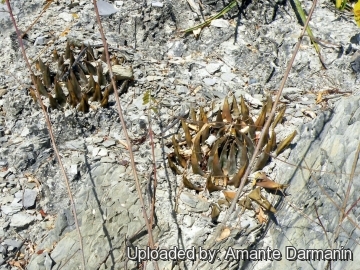 Ariocarpus trigonus v. elongatus, Near La Reforma, Tamaulipas. (Ariocarpus elongatus) Photo by: Amante Darmanin
Ariocarpus trigonus v. elongatus, Near La Reforma, Tamaulipas. (Ariocarpus elongatus) Photo by: Amante Darmanin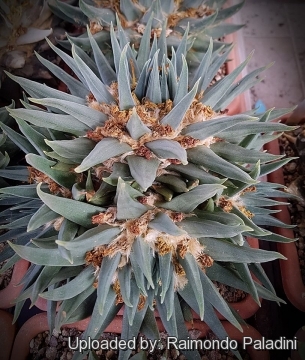 Mammillaria elongata (Ariocarpus elongatus) Photo by: Raimondo Paladini
Mammillaria elongata (Ariocarpus elongatus) Photo by: Raimondo Paladini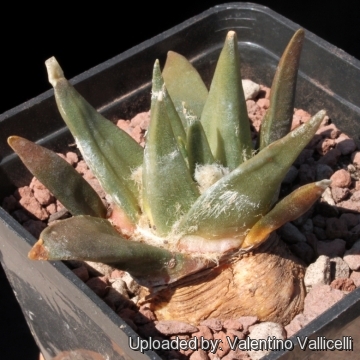 Mammillaria elongata (Ariocarpus elongatus) Photo by: Valentino Vallicelli
Mammillaria elongata (Ariocarpus elongatus) Photo by: Valentino Vallicelli Mammillaria elongata (Ariocarpus elongatus) Photo by: Raimondo Paladini
Mammillaria elongata (Ariocarpus elongatus) Photo by: Raimondo Paladini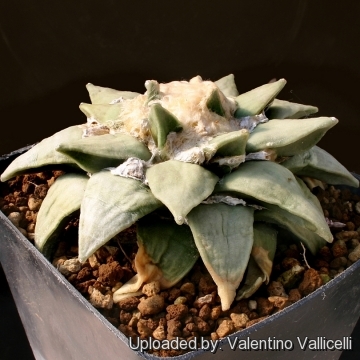 Mammillaria elongata (Ariocarpus elongatus) Photo by: Valentino Vallicelli
Mammillaria elongata (Ariocarpus elongatus) Photo by: Valentino Vallicelli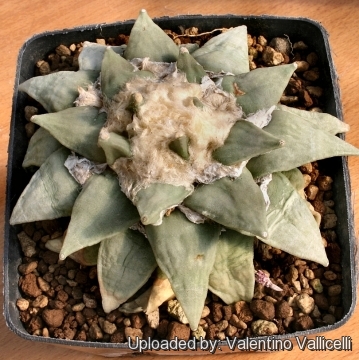 Mammillaria elongata (Ariocarpus elongatus) Photo by: Valentino Vallicelli
Mammillaria elongata (Ariocarpus elongatus) Photo by: Valentino Vallicelli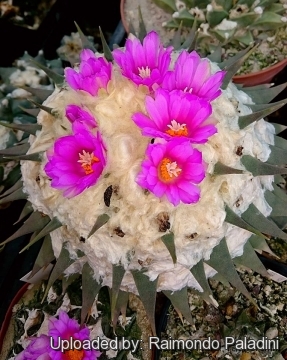 Mammillaria elongata (Ariocarpus elongatus) Photo by: Raimondo Paladini
Mammillaria elongata (Ariocarpus elongatus) Photo by: Raimondo Paladini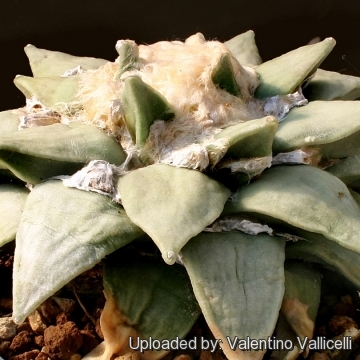 Mammillaria elongata (Ariocarpus elongatus) Photo by: Valentino Vallicelli
Mammillaria elongata (Ariocarpus elongatus) Photo by: Valentino VallicelliCultivation and Propagation: This species is slow-growing, but certainly not as slow as some other types of cacti. It is of easy cultivation in a well-drained, non-organic, free-draining soil compost, with ample water during the growing season. Use of a weak low-nitrogen fertilizer during the growing season can encourage growth. The main threat to their development is root rot. Ariocarpus should be kept dry whenever there is a threat of cold. The appearance of Ariocarpus can benefit greatly by watering the plants from the bottom. This practice will help to keep the “wool” on the top of the plant from becoming matted or discoloured. It needs light shade to full sun.
Frost Tolerance: Hardy to -10° C
Propagation: It is probably the easiest species of the genus to raise from seed, but will generally take about 6-10 years to reach flowering size, occasionally grafted.
Your Photos
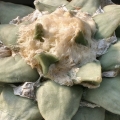
by Valentino Vallicelli




















